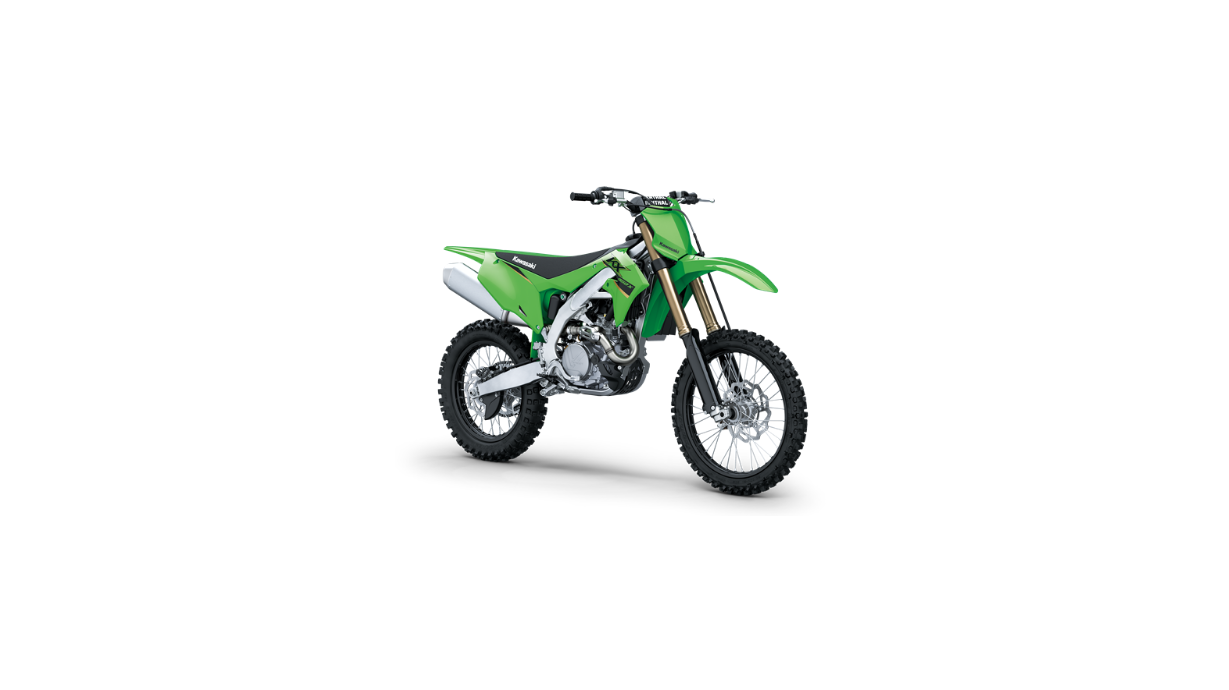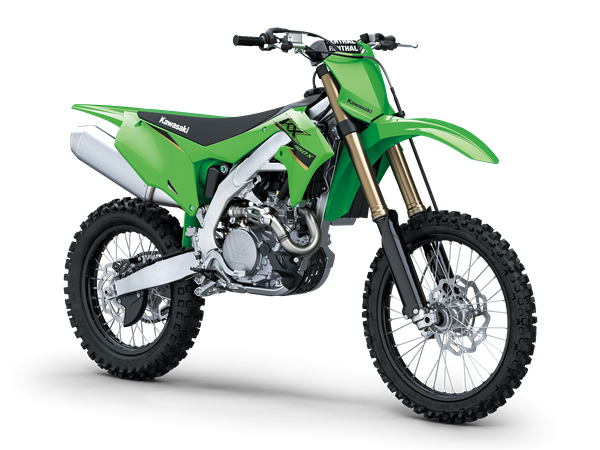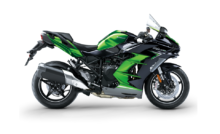2022 Kawasaki KX450X Spark Plug Owners Manual




2022 Kawasaki KX450X Spark Plug


Spark Plug
The spark plug should be taken out periodically for inspection and recapping. Measure the gap with a wire-type thickness gauge. If incorrect, adjust the gap to the specified value by bending the outer electrode.
Spark Plug Gap
A. Gap
B. Outer Electrode
If the plug is oily or has carbon built up on it, clean it. The plug may also be cleaned using a high flash point solvent and a nonmetal brush (nylon etc.). If the spark plug electrodes are corroded or damaged, or if the insulator is cracked, replace the plug. The standard spark plug is shown in the table below.
Standard Spark Plug
- NGK CPRSEB-9
To find out whether the plug’s heat range is correct, remove the plug and examine the ceramic insulator around the center electrode. If the ceramic is light brown, the spark plug correctly matches the engine temperature.
If the ceramic is burned white, the plug should be replaced with a colder plug
Optional Spark Plug
- Colder
- NGK CPR9EB-9
NOTE
If the engine performance drops, try replacing the spark plug to regain performance.
Spark Plug Removal and Installation
- Remove the seat bolts.
- Lift the rear part of the seat upward and slide the seat rearward.
A. Seat Bolts
B. Seat
C. Upward
D. Rearward
- Remove the left side cover (see Air Cleaner section).
- Remove the right side cover (see Exhaust System section).
- Remove the radiator shroud bolts and take off the radiator shroud on both sides.
A. Radiator Shroud Bolts
B. Radiator Shroud
- Remove the band and fuel tank bolt.
A. Fuel Tank Bolt
B. Band
- Be sure to place a piece of cloth around the fuel hose joint.
- Wipe off the dirt of the surface around the connection using a cloth ora soft brush.
- Insert a flat tip screwdriver into the slit on the joint lock.
A. Flat Tip Screwdriver
B. Joint Lock
- WARNING
Fuel is flammable and explosive under certain conditions and can cause severe burns. Be prepared for fuel spillage; any spilled fuel must be completely wiped up immediately. When the fuel hose is disconnected, fuel spills out from the hose and the pipe because of residual pressure. - Cover the hose connection with a piece of clean cloth to prevent fuel spillage.
- Turn the driver to disconnect the joint lock.
- Disconnect the fuel hose joint from the outlet pipe.
A. Turn
B. Joint Lock
C. Fuel Hose Joint
- Cover the outlet pipe and the fuel hose joint with the vinyl bags to keep them clean.
- Open the clamps and disconnect the fuel pump lead connector.
- Remove the fuel tank.
A. Clamps
B. Fuel Pump Lead Connector - WARNING
- Gasoline is extremely flammable and can be explosive under certain conditions.
- Always stop the engine and do not smoke.
- Make sure the area is well-ventilated and free from any source of flame or sparks; this includes any appliance with a pilot light.
- Clean the cylinder head cover around the spark plug cap hole before removing the spark plug.
- Remove the bolt and plug the cap retainer plate.
- Pull the spark plug cap off the plug.
- NOTICE
When removing the spark plug cap, do not pull the lead. The lead could be broken off or damaged the wires inside.
A. Bolt
B. Plug Cap Retainer Plate
C. Spark Plug Cap
- Loosen and remove the spark plug with a suitable wrench (16 mm, 0.63 in.).
- When reinstalling the spark plug, torque it to specification.
- Tightening Torque
- Spark Plug
- 13 Nm (1.3 kgfm, 115 in-lb)
- Spark Plug
- Install the spark plug cap so that it is aligned with the line on the cylinder head cover.
- Pull up the plug cap lightly to make sure of the installation of the spark plug cap.
A. Spark Plug Cap
B. Line
- Install the plug cap retainer plate as shown.
- Tighten the plug cap retainer plate bolt to the specified torque.
A. Plug Cap Retainer Plate
B. Plug Cap Retainer Plate Bolt
- Tightening Torque
- Plug Cap Retainer Plate Bolt
- 10 Nm (1.0 kgfm, 89 in-b)
- Plug Cap Retainer Plate Bolt
- Make sure that the dampers are in place on the frame and are not damaged. If the dampers are not fixed completely, reattach them with an adhesive. If the dampers are damaged, replace them with new ones.
A. Dampers
- Check the joint lock for deformation and wear.
- If the joint lock is deformed, replace the fuel hose with a new one.
- Apply engine oil to the fuel outlet pipe lightly.
- Insert the fuel hose joint straight onto the fuel outlet pipe until the hose joint clicks.
- Push the joint lock until the hose joint clicks.
A. Fuel Hose Joint
B. Joint Lock
NOTICE
- When installing the fuel hose joint, do not apply strong force to the outlet pipe on the fuel pump. The pipe made from resin could be damaged.
- Push and pull the fuel hose joint back and forth more than two times, and make sure it is locked and does not come off.
A. Fuel Hose Joint
B. Push and Pull
WARNING
Leaking fuel can cause a fire or explosion resulting in serious burns. Make sure the hose joint is installed correctly on the delivery pipe by sliding the joint.
- NOTE
- fit comes off, reinstall the fuel hose joint.
- Run the fuel pump lead over the fuel hose.
- Before installing the fuel tank, check that both throttle cables run over the main harness.
- NOTE
- To prevent the bottom of the fuel tank from pushing the throttle cables, run the throttle cables over the main harness correctly.
- Tighten the fuel tank bolt to the specified torque.
- Tightening Torque
- Fuel Tank Bolt
- 8.0 Nm (0.82 kgfm, 71 in-lb)
- Fuel Tank Bolt
- Hook the band to the fuel tank.
- After installing the fuel tank, make sure that both throttle cables (outer) move slightly by pulling them back and forth in the upper space of the right side of the fuel tank. Check that both throttle cables run under the frame (right side) as shown.
A. Throttle Cables
B. Fuel Tank
C. Bottom of the Frame (Right Side)
- Install the radiator shroud.
- Tighten the radiator shroud bolts to the specified torque.
A. Radiator Shroud
B. Radiator Shroud Bolts
- Tightening Torque
- Radiator Shroud Bolts
- 7.0 Nm (0.71 kgfm, 62 in-lb)
- Radiator Shroud Bolts
- Install the right side cover (see Exhaust System section).
- Install the left side cover (see Air Cleaner section).
- Insert the hooks of the seat under the flange collar and frame.
A. Hooks
B. Seat
C. Flange Collar
D. Frame
- Tighten the seat bolt on both sides to the specified torque.
A. Seat Bolts
- Tightening Torque
- Seat Bolts
- 25 Nm (2.5 kgfm, 18 ft:lb)
- Seat Bolts
NOTE
Insert the fuel tank breather hose outlet end into the steering stem hole.
Recent Posts
VW Jetta Engine Fuse Box Diagram
Access the comprehensive 2010-2018 VW Jetta Passenger Fuse Box Diagram to troubleshoot electrical issues effectively.…
VW Jetta Passenger Fuse Box Diagram
Explore the comprehensive VW Jetta Passenger Fuse Box Diagram to troubleshoot electrical issues effectively. Understand…
2023 Ford F-150 Lightning Fuse Box Diagram
Under Hood Fuse Box Location Remove the front luggage compartment cover. Under Hood Fuse Box…
2022 Kawasaki NINJA H2 SX SE Brake Lever Adjuster Owner’s Manual
2022 Kawasaki NINJA H2 SX SE Brake Lever Adjuster Owner's Manual NOTICE Only adjust the front…
2023 Land Rover Range Rover Evoque Exiting The Vehicle Owners Manual
2023 Land Rover Range Rover Evoque Exiting The Vehicle SINGLE LOCKING WARNING Before exiting the…
2023 Land Rover Range Rover Evoque Front Seats Owners Manual
2023 Land Rover Range Rover Evoque Front Seats FRONT SEAT SAFETY Make sure to read…
